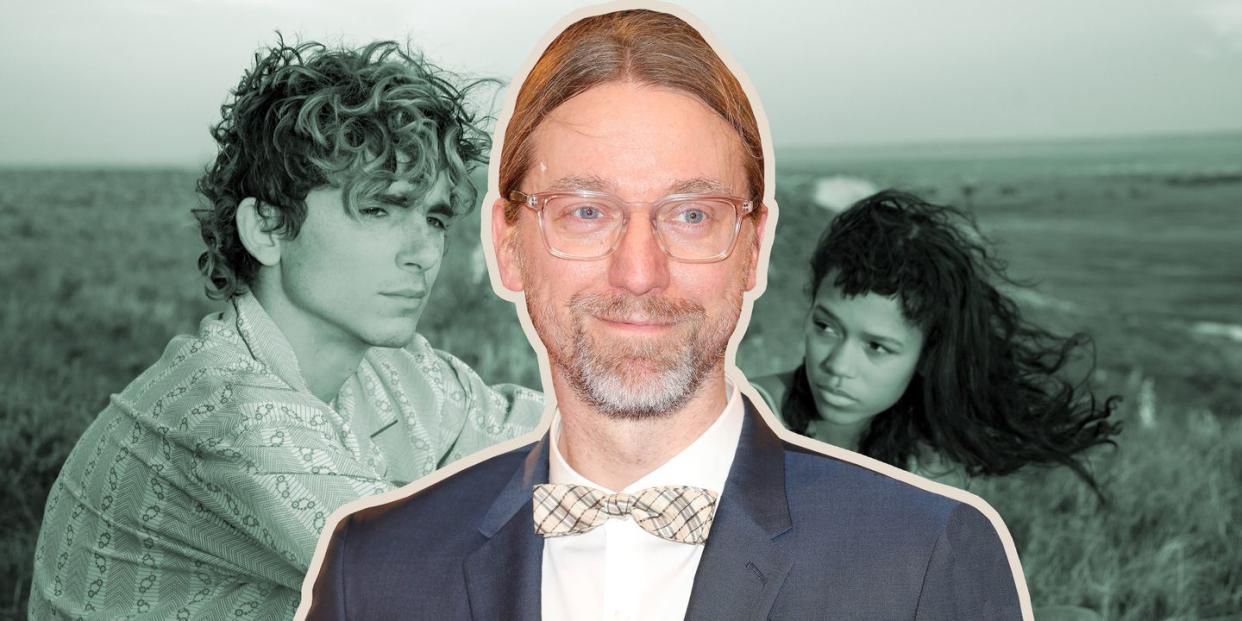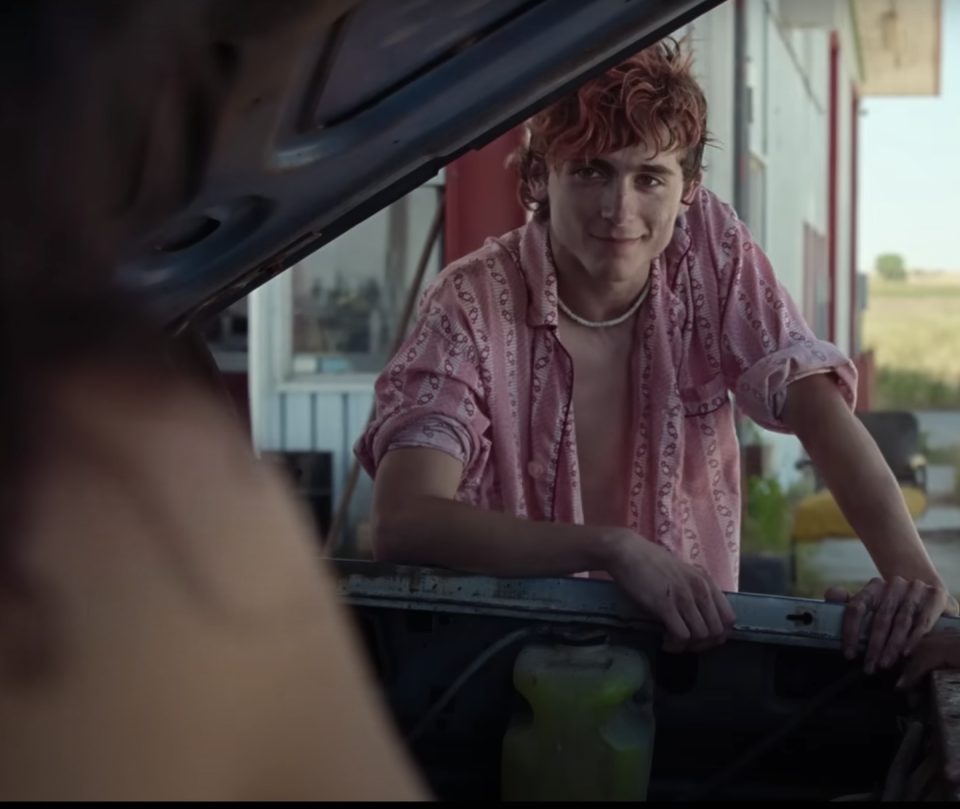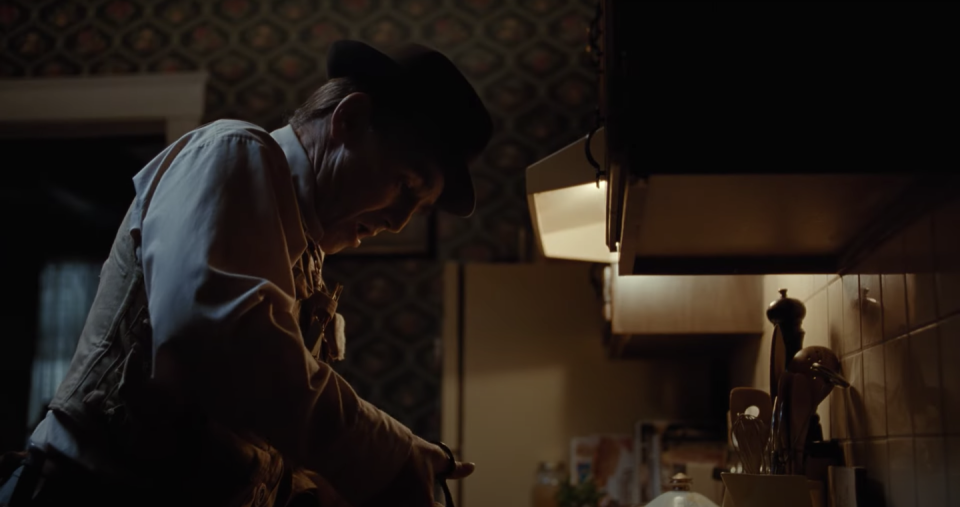How 'Bones and All' Pulled Off Its Bizarro Love Story

- Oops!Something went wrong.Please try again later.
- Oops!Something went wrong.Please try again later.
- Oops!Something went wrong.Please try again later.
For David Kajganich, screenwriter and producer of Luca Guadagnino's newest film, Bones and All, the phrase "cannibal love story" holds a certain appeal. Kajganich, a fan of genre storytelling in all its forms, cut his teeth writing horror and thriller fare like The Invasion (a remake of Invasion of the Body Snatchers starring Nicole Kidman and Daniel Craig), Blood Creek (Joel Schumacher's occult Nazi horror film), and True Story (a cat-and-mouse crime thriller). Then, he fell in love with Guadagnino's ever-growing band of misfits.
Bones and All, adapted from Camille DeAngelis' 2015 young adult novel, is Kajganich and Guadagnino’s third collaboration, following the sexy and sun-soaked drama A Bigger Splash and the astonishing remake of Dario Argento's Suspiria. The news of Guadagnino directing a teen cannibal romance struck many as odd—and darkly fascinating too, given the allegations swirling around a previous Guadagnino star. But Bones and All is a far stranger and richer film than the bloody slasher you might expect from reading the description, thanks to its director's haunting and sly aesthetic sensibilities, as well as his screenwriter-collaborator's knack for finding an empathetic and even romantic way of telling the grossest tale. (Kajganich also adapted the first season of The Terror, based on Dan Simmons' historical arctic horror novel, in which a boat full of icebound sailors must do the unthinkable to survive while maybe being stalked by a giant creature.)
The film stars Taylor Russell as Maren, a young girl who finds herself anchorless after her uncontrollable compulsion to consume human flesh sets her adrift from society. She cruises around the country, chancing upon other "eaters" and falling in with Lee (Timotheé Chalamet), another eater like her who spends his time traveling from state to state, always on the move. To get to the meat of the narrative (sorry), Esquire spoke with Kajganich about adapting DeAngelis' strange and compelling style, why cannibalism is so hot right now, and knowing when to hold back on all the blood and guts.
ESQUIRE: This movie gets pretty bloody. How do you decide on the “ick factor” level?
DAVID KAJGANICH: You have to have two things in mind. One is, where are you putting the bead on the continuum of allegory versus naturalism? We couldn't really adopt the fairytale ethos of the novel, because we were aiming for something quite naturalistic in terms of the logistics of these people's lives. But we didn't want to brutalize anyone. For me, it was enough in the script, and I think it's enough in the film, so that you feel some real conflict about the building empathy you have toward them when they commit these acts of cannibalism. You feel their otherness. That was the important thing about it. Not that the audience was shocked or scared or surprised or grossed out. That comes with the territory.
As an audience member, you catch yourself thinking, "Yes, of course, this feels totally natural" about things that are not natural at all. How do you get the story to that point?
One tool I have that every screenwriter does is how you handle dialogue—specifically how you handle exposition. As soon as an audience understands that there are lines in the film that are for them, rather than for the characters speaking to one another, you start to have a sense of expectation that the film will tell you what you need to know and how to feel. I tried very hard to push against expository dialogue for the audience. The verisimilitude is heightened by that because the audience is no longer feeling a tutorial relationship with what they're watching. They feel just as if they're witnessing. Sometimes that means an audience could be confused, but a mild level of confusion to me is a sign that it's going well, actually.

I loved how the viewer doesn't really know how widespread any of this is. There's not anyone who explains, “Here are the eaters, and here's how many there are in the world, and this is what you're dealing with.”
No. And that's part and parcel of wanting to give this to the audience with some ambiguity about how they're meant to receive it. Is it mythology? Is it metaphor, is it allegory, is it something that's meant to problematize or subvert your relationship to the characters? It's a little bit of all of those things. I think the moment you feel like a character is displaying himself or herself to the audience for understanding, you've gone too far. When characters display themselves to one another for understanding, it's an entirely different thing. This film is built on that engine of these characters revealing themselves to one another, and out of that grows affection, and then love and then tragedy.
This is your third collaboration with Luca Guadagnino. How did you first find each other?
Well, he came along in my life at the moment that I needed him to. I had promised myself when I moved out to Los Angeles to start a screenwriting career that if I got to the point where I had my name on three films that I wasn't proud of, that I would leave that and go back to the life I had left behind. I was teaching at a university, I had wonderful friends, I was living in a place I loved, and I risked all of that to try a screenwriting career. And so, when the third film came along with my name on it, and it had been rewritten half to death, and it wasn't something that I was excited about, let alone proud of, I thought, “Well, maybe it's fine.” That month, I got a call that Luca Guadagnino, whose films I love, wanted to send me a film. It was La Piscine, the Jacques Deray film that became the remake called A Bigger Splash. I thought to myself, “I don't know why someone would want to remake this film that seems to exist as a tone poem for a very specific moment.” It mostly works because of the cast; the two leads were in a contentious phase of their relationship, and people thought it was really exciting to watch them play these conflicted lovers onscreen. When you take that away, I didn't really understand what was left. So I said, "Look, I would love to work together, but I don't understand what's here for us to do." And he said, "That's the answer I want. So let's start from scratch."
What was the impetus for you two working on Bones and All?
It was the reverse. He invited me into the family to make A Bigger Splash. He invited me to help him with the Suspiria remake he was planning. At the time, I had been sent Bones And All by the originating producer Theresa Park. I thought it was such an intriguing premise. I love the characters. I was a bit concerned that the author [Camille DeAngelis] might prefer that a woman write the script because even though it's about cannibals, it did feel like a personal book to me. I spoke with her at length, and she was very happy with my point of view about it. It's a very odd tone. It's a very strange mix of genres. Having worked once with Luca, and ramping up to work again with Luca, I thought, “Well, I do trust him a great deal.”
Sure, there's cannibalism in the film. It’s the great tragedy of these characters' lives that they're trying to negotiate. But I knew the heart of the story was the idea of a young woman coming into her identity and finding someone that she can really share her otherness with, who can see her without judgment and with love. When you think of that film, that's obviously something that a director like Luca would do extremely well.
These three movies all revolve around female characters who have powerful tendencies towards violence, either emotional or physical. How do you get into the head of a character like that?
I care so much about empathy being the primary currency of what we do in this industry. I try to shy away from people who don't agree and gravitate to people who do. I get very nervous about taking on jobs like these jobs. When people see the film or read the script, I want them to feel that I had, rather than written female characters well, instead listened enough to empathize with the women in the film. I just cling to this idea that if what we're doing in telling stories isn't trying to empathize with people who aren't like us, whether we're talking about gender, various orientations, class, academic background, whatever it is—unless we're working against the tide of those differences somehow, then I don't know what I'm doing as a writer.
What was it about DeAngelis’ book that immediately made you think, “This is something that I really want to work on”?
Well, the tone of it is so strange. I knew that the tone of the film couldn't be the same tone, exactly. I knew the film would have to be more literal, somehow. As a creative challenge, that was very appealing. But mostly, I couldn't see how anyone could either read or watch the story and not feel it personally. For me, it becomes a bit of a metaphor for growing up gay in the Midwest at a time when people were saying, "Don't ask, don't tell" instead of, "It gets better." I felt for the characters in the book being pushed further and further to the edge. That’s something that so many people can empathize with, because we push each other around so much in that way, particularly young people. Young love is such an anxious endeavor.
This is a hard-R film. We didn't do that because we thought we were sharpening or smartening the book. We did it because the subject matter requires a level of visual candor. I do have some regret over the idea that it will be harder for younger people to see this. But I'm also not an idiot, and anybody who wants to see it would find a way. It's not that I would love a bunch of 12-year-olds to watch some of the more violent scenes in the film. But I hope the feeling you're left with after the film is one that is particularly healing for younger people. It’s just strange to have the delivery system be this R-rated cannibalism movie.
It's a rite of passage to watch a movie you're not really supposed to. I'm all for that.
[Laughs] Yeah, maybe we shouldn't say that.

Speaking of books, I noticed that the characters in this film are always reading.
That's something that Camille did. Books are holy objects in the novel. I took the liberty of replacing some of the specific books with books that were more appropriate for the period in which our film is set, because the book is not set in the '80s. It's one more thing that makes Maren a really touching character. She's a young person who wants exposure to more of the world she's in.
I was also so impressed by and so drawn to Mark Rylance's Sully. He is so scary, almost immediately, yet he's presented at first as this sad, lonely, weirdo. How do you build a character like that?
If somebody has been alone and disenfranchised, existing entirely through various adaptive strategies and coping strategies, his psyche will calcify. He is the future that's coming for Maren and Lee if they can't find ways to connect to people. There's so much pathos in that. Living on the margins for so long has created a void in him, where his understanding of how love works has all been curdled.
He never broke character, by the way. He always had that accent. It got to be upsetting. I was sitting reading in the kitchen of that house; it was very hot the summer we shot that, and I had my sleeves rolled up. I felt someone sort of standing next to me and I was about to look up. Then I heard that voice and he said, "You better roll your sleeve down, boy. I'm hungry."
Cannibalism is in the ether right now. What's up with that?
When we were dealing with cannibalism in The Terror, which we did because it really did happen on that expedition, my thought about it was that we have to understand it as practically as possible. We have to understand it as a decision that reasonable people in an unreasonable situation are making. That was really good training for writing Bones and All because it didn't have a fetishized mystique to me. I'd already thought so much about the practicalities of it. In The Terror, they don't have a choice. I guess they do, but the choice is death. In Bones and All, these characters don't have a choice for a different reason. Those are my two versions of cannibalism. That's not a sentence I ever thought I would say.
There's plenty of fetishization of it going on in the culture right now. I think it's an improvement, frankly, because for ten years, the primary trope we had in horror was zombies. Dead people eating living people. We now seem to have graduated to living people eating living people. I think that says something good—we're ready for some kind of actual engagement and conflict with one another instead of with metaphors for the anxieties that haunt us.
You Might Also Like

